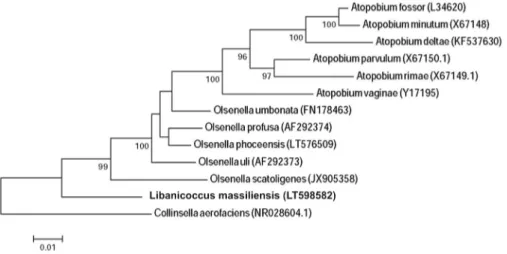HAL Id: hal-01795910
https://hal-amu.archives-ouvertes.fr/hal-01795910
Submitted on 1 Jun 2018
HAL is a multi-disciplinary open access
archive for the deposit and dissemination of
sci-entific research documents, whether they are
pub-lished or not. The documents may come from
teaching and research institutions in France or
abroad, or from public or private research centers.
L’archive ouverte pluridisciplinaire HAL, est
destinée au dépôt et à la diffusion de documents
scientifiques de niveau recherche, publiés ou non,
émanant des établissements d’enseignement et de
recherche français ou étrangers, des laboratoires
publics ou privés.
“Libanicoccus massiliensis” gen. nov., sp. nov., a new
bacterium isolated from a stool sample from a pygmy
woman
M. Bilen, F. Cadoret, Pierre-Edouard Fournier, Z. Daoud, Didier Raoult
To cite this version:
M. Bilen, F. Cadoret, Pierre-Edouard Fournier, Z. Daoud, Didier Raoult. “Libanicoccus massiliensis”
gen. nov., sp. nov., a new bacterium isolated from a stool sample from a pygmy woman. New
Microbes and New Infections, Wiley Online Library 2017, 15, pp.40-41. �10.1016/j.nmni.2016.10.006�.
�hal-01795910�
NEW SPECIES
“Libanicoccus massiliensis” gen. nov., sp. nov., a new bacterium isolated
from a stool sample from a pygmy woman
M. Bilen1, F. Cadoret1, P.-E. Fournier1, Z. Daoud2and D. Raoult1
1) Aix-Marseille Université, URMITE, UM63, CNRS7278, IRD198, Inserm 1095, Institut Hospitalo-Universitaire Méditerranée-Infection, Faculté de médecine, Marseille, France and 2) Clinical Microbiology Laboratory, Saint George University Hospital, Faculty of Health Sciences, University of Balamand, Beirut, Lebanon
Abstract
This study supports the main characteristics of a new genus“Libanicoccus massiliensis” strain Marseille-P3237 (CSURP3237); a new member of the order Coribacteriaceae that was isolated from a stool sample from a healthy 35-year-old pygmy woman.
© 2016 The Authors. Published by Elsevier Ltd on behalf of European Society of Clinical Microbiology and Infectious Diseases. Keywords: Culturomics, emerging bacteria, gut microbiota, human microbiota, Libanicoccus massiliensis
Original Submission: 16 September 2016; Revised Submission: 4 October 2016; Accepted: 14 October 2016 Article published online: 20 October 2016
Corresponding author: D. Raoult, Aix-Marseille Université, URMITE, UM63, CNRS7278, IRD198, Inserm 1095, Institut Hospitalo-Universitaire Méditerranée-Infection, Faculté de médecine, 27 Boulevard Jean Moulin, 13385, Marseille cedex 05, France E-mail:didier.raoult@gmail.com
Samples were collected in Congo in 2015 as part of the analysis project of human microbiome by culturomics [1]. This study was approved by the ethics committee of the Institut Federatif de Recherche IFR48 (Marseille, France) under number 09-022. Samples were diluted with phosphate-buffered saline and inoculated in a blood culture media supplemented with 5 mL blood and rumen at 37°C under anaerobic conditions. After 5 days of growth, Libanicoccus massiliensis was isolated on 5% sheep’s blood–enriched Columbia agar (bioMérieux, Marcy l’Etoile, France). Colonies were rough, with a mean diameter of 0.8 to 1.2 mm. Strain Marseille-P3237 cells are cocci, Gram negative, catalase and oxidase negative with an average diameter of 1.06μm. This strain could not be identified by our systematic matrix-assisted laser desorption/ionization time-of-flight mass spectrometry (MALDI-TOF MS) screening on a Microflex spectrometer (Bruker Daltonics, Bremen, Germany)[2]. Thus, 16S rRNA gene sequencing was performed using fD1-rP2 primers as previously described (Eurogentec, Seraing, Belgium) by a 3130-XL sequencer (Applied Biosciences, Saint Aubin, France)[3].
L. massiliensis exhibited a 93.05% sequence identity with Olsenella uli strain DSM7084 (NR_074414), the phylogenetically closest species published with standing in nomenclature (Fig. 1). Thus, strain Marseille-P3237 exhibits a 16S rRNA sequence divergence of >5% with its phylogenetically closest species with a validly published name with standing in nomenclature [4]. We propose the creation of a new genus, “Libanicoccus” (Li.ba.ni.coc’cus, N.L. masc.gen.n., Libanicoccus to refer to the Lebanese nationality for of the person who cultivated strain Marseille-P3237). Marseille-P3237 is the type strain of the new species “Libanicoccus massiliensis” gen. nov., sp. nov. (mas.i-l.i.en’sis, L. gen. masc. n., massiliensis pertaining to Massilia, the ancient name of the city of Marseille, where this bacterium was discovered). The sample was isolated from a stool sample from a healthy 35-year-old pygmy woman.
MALDI-TOF MS spectrum accession number
The MALDI-TOF MS spectrum of L. massiliensis is available online (http://www.mediterranee-infection.com/article.php? laref=256&titre=urms-database).
Nucleotide sequence accession number
The 16s rRNA gene sequence was deposited in GenBank under accession number LT598582.1.
New Microbe and New Infect 2017; 15: 40–41
© 2016 The Authors. Published by Elsevier Ltd on behalf of European Society of Clinical Microbiology and Infectious Diseases This is an open access article under the CC BY-NC-ND license (http://creativecommons.org/licenses/by-nc-nd/4.0/) http://dx.doi.org/10.1016/j.nmni.2016.10.006
Deposit in a culture collection
Strain Marseille-P3237 was deposited in the Collection de Souches de l’Unité des Rickettsies (CSUR, WDCM 875) under number P3237.
Acknowledgement
This study was funded by the Fondation Méditerranée Infection.
Conflict of interest
None declared.
References
[1] Lagier JC, Hugon P, Khelaifia S, Fournier PE, La Scola B, Raoult D. The rebirth of culture in microbiology through the example of culturo-mics to study human gut microbiota. Clin Microbiol Rev 2015;28: 237–64.
[2] Seng P, Abat C, Rolain JM, Colson P, Lagier JC, Gouriet F, et al. Iden-tification of rare pathogenic bacteria in a clinical microbiology labora-tory: impact of matrix-assisted laser desorption ionization–time of flight mass spectrometry. J Clin Microbiol 2013;51:2182–94.
[3] Drancourt M, Bollet C, Carlioz A, Martelin R, Gayral JP, Raoult D. 16S ribosomal DNA sequence analysis of a large collection of environmental and clinical unidentifiable bacterial isolates. J Clin Microbiol 2000;38: 3623–30.
[4] Kim M, Oh HS, Park SC, Chun J. Towards a taxonomic coherence between average nucleotide identity and 16S rRNA gene sequence similarity for species demarcation of prokaryotes. Int J Syst Evol Microbiol 2014;64:346–51.
FIG. 1. Phylogenetic tree showing position of Libanicoccus massiliensis
strain Marseille-P3237 between
phylogenetically closest species. CLUSTALW was used for sequences alignment, and phylogenetic inferences were generated by MEGA software by maximum likelihood method. Boot-strap values obtained after 500 repeats are shown on nodes. Bootstrap scores of at least 90% were kept. Scale bar indicates 2% nucleotide sequence divergence.
NMNI
Bilenet al. “Libanus massiliensis” 41© 2016 The Authors. Published by Elsevier Ltd on behalf of European Society of Clinical Microbiology and Infectious Diseases, NMNI, 15, 40–41 This is an open access article under the CC BY-NC-ND license (http://creativecommons.org/licenses/by-nc-nd/4.0/).
